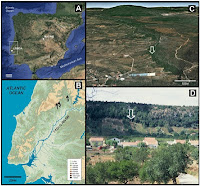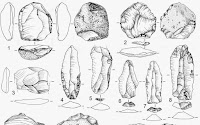Recent studies of the genomes of ancient and modern peoples have provided considerable insight into the migration of modern Humans from Africa through Asia and into Australasia, but similar studies into the origin of modern Europeans have so far been lacking. Studies of early Europeans based upon archaeological evidence have suggested two possibly scenarios, that Europe was settled once as part of a single dispersal of Modern Humans from Africa into Eurasia, or that it was settled more gradually by a continuous trickle of migrants.
In a paper published in the journal Current Biology on 21 March 2016, a team of scientists led by Cosimo Posth of the Institute for Archaeological Sciences at the University of Tübingen and the Max Planck Institute for the Science of Human History examine the mitochondrial genomes of 55 pre-Neolithic Modern Humans from archaeological sites in Europe, dating to between 35 000 and 7000 years old, including 35 newly sequenced genomes, and 20 previously published ones, and compare them to 311 modern and 66 ancient genomes from around the globe in order to develop a model of the migration of Modern Humans into Europe.
Because mitochondrial DNA is found in the mitochondria, organelles outside the cell nucleus, it is passed directly from mother to child without being sexually recombined each generation, enabling precise estimations of when individuals shared common ancestors, at least through the female line (it is also possible to trace direct ancestry through the male line, using DNA from the Y chromosome, which is passed directly from father to son without sexual recombination).
All modern non-Africans belong to two haplogroups, M and N (a haplogroup is a group of individuals shown to share a common ancestry through the male or female line, using either mitochondrial or Y chromosome DNA), members of the M haplogroup are thought to have shared a single common ancestor about 50 000 years ago, while members of the N haplogroup are thought to have shared a single common ancestor about 59 000 years ago. However while both haplogroups are fairly common in Asians, Australasians and Native Americans, the M haplogroup is almost completely absent from modern European populations.
A single European specimen was found not to belong to either haplogroup, however this specimen Oase 1, a ~40 000 year old jawbone from Romania, is known not to be ancestral to any subsequent Human population. The remaining Late Pleistocene samples included the M haplogroup, as well as four separate subgroups within the N haplogroup, R, U, U5 and U2'3'4'7'8'9. However the European population went through a series of bottlenecks at the end of the Pleistocene, associated with the last Glacial Maximum, between 25 000 and 19 500 years ago, the Bølling-Allerød Interstadial, a warm period at the end of the last Ice Age lasting from 19 500 to about 14 500 years ago, and the Younger Dryas, a return to glacial conditions that lasted from about 14 500 to about 11 500 years ago, the end of which is considered to mark the end of the Pleistocene and beginning of the Holocene.
Prior to the Last Glacial Maximum as well as the M haplogroup, all four subgroups of the N haplogroup were present in Europe, but after the it only the U5 and U2'3'4'7'8'9 groups were present, with the U2'3'4'7'8'9 group being much more common than the U5. However following the Younger Dryas cold period this situation was reversed, With the majority of Early Holocene Europeans belonging to the U5 haplogroup. This strongly suggests that the population bottlenecks at the end of the Pleistocene were linked to glaciations, with the Human population being reduced several times to small pockets of individuals living in isolated glacial refugia, then recolonising the rest of the continent when the climate improved.
See also...
 Animal remains from Middle Neolithic deposits at the Pena d’Água Rock-shelter of Portugal. Middle Neolithic remains are known from a number of archaeological sites
across Portugal, and have been studied since the nineteenth century.
However historically almost all studies of this material have
concentrated on funerary behavior rather than...
Animal remains from Middle Neolithic deposits at the Pena d’Água Rock-shelter of Portugal. Middle Neolithic remains are known from a number of archaeological sites
across Portugal, and have been studied since the nineteenth century.
However historically almost all studies of this material have
concentrated on funerary behavior rather than...
 Neanderthal DNA from a 37 000-42 000 modern Human jaw from Romania. Neanderthals first appeared in
Europe around 300 000 years ago and were replaced by anatomically modern Humans
between 45 000 and 35 000 years ago. Genetic studies if modern Human
populations show that almost all non-Africans have traces of Neanderthal...
Neanderthal DNA from a 37 000-42 000 modern Human jaw from Romania. Neanderthals first appeared in
Europe around 300 000 years ago and were replaced by anatomically modern Humans
between 45 000 and 35 000 years ago. Genetic studies if modern Human
populations show that almost all non-Africans have traces of Neanderthal...
 Acheulian and Levallois technologies from a single Late Pleistocene site Armenia. Stone tools associated with the Acheulian technology first appeared
around 1.75 million years ago and spread across much of Eurasia from about 900
000 years...
Acheulian and Levallois technologies from a single Late Pleistocene site Armenia. Stone tools associated with the Acheulian technology first appeared
around 1.75 million years ago and spread across much of Eurasia from about 900
000 years...
Follow Sciency Thoughts on Facebook.
Because mitochondrial DNA is found in the mitochondria, organelles outside the cell nucleus, it is passed directly from mother to child without being sexually recombined each generation, enabling precise estimations of when individuals shared common ancestors, at least through the female line (it is also possible to trace direct ancestry through the male line, using DNA from the Y chromosome, which is passed directly from father to son without sexual recombination).
All modern non-Africans belong to two haplogroups, M and N (a haplogroup is a group of individuals shown to share a common ancestry through the male or female line, using either mitochondrial or Y chromosome DNA), members of the M haplogroup are thought to have shared a single common ancestor about 50 000 years ago, while members of the N haplogroup are thought to have shared a single common ancestor about 59 000 years ago. However while both haplogroups are fairly common in Asians, Australasians and Native Americans, the M haplogroup is almost completely absent from modern European populations.
A single European specimen was found not to belong to either haplogroup, however this specimen Oase 1, a ~40 000 year old jawbone from Romania, is known not to be ancestral to any subsequent Human population. The remaining Late Pleistocene samples included the M haplogroup, as well as four separate subgroups within the N haplogroup, R, U, U5 and U2'3'4'7'8'9. However the European population went through a series of bottlenecks at the end of the Pleistocene, associated with the last Glacial Maximum, between 25 000 and 19 500 years ago, the Bølling-Allerød Interstadial, a warm period at the end of the last Ice Age lasting from 19 500 to about 14 500 years ago, and the Younger Dryas, a return to glacial conditions that lasted from about 14 500 to about 11 500 years ago, the end of which is considered to mark the end of the Pleistocene and beginning of the Holocene.
Late Pleistocene and Early Holocene Archeological Sites and Hunter-Gatherer mtDNA Haplogroups. (A) Pre-Last Glacial Maximum dispersal of non-African populations, carrying both M and N lineages (haplogroups R, U, U5, and U2'3'4'7'8'9 belong to the N clade, distinct from the M clade). (B) Post-Last Glacial Maximum re-expansion in Europe while ice sheets retracted. (C) Late Glacial shift in mtDNA haplogroup frequency. (D) Holocene hunter-gatherer mtDNA, mainly belonging to haplogroup U5. Posth et al. (2016).
Prior to the Last Glacial Maximum as well as the M haplogroup, all four subgroups of the N haplogroup were present in Europe, but after the it only the U5 and U2'3'4'7'8'9 groups were present, with the U2'3'4'7'8'9 group being much more common than the U5. However following the Younger Dryas cold period this situation was reversed, With the majority of Early Holocene Europeans belonging to the U5 haplogroup. This strongly suggests that the population bottlenecks at the end of the Pleistocene were linked to glaciations, with the Human population being reduced several times to small pockets of individuals living in isolated glacial refugia, then recolonising the rest of the continent when the climate improved.
See also...
 Animal remains from Middle Neolithic deposits at the Pena d’Água Rock-shelter of Portugal. Middle Neolithic remains are known from a number of archaeological sites
across Portugal, and have been studied since the nineteenth century.
However historically almost all studies of this material have
concentrated on funerary behavior rather than...
Animal remains from Middle Neolithic deposits at the Pena d’Água Rock-shelter of Portugal. Middle Neolithic remains are known from a number of archaeological sites
across Portugal, and have been studied since the nineteenth century.
However historically almost all studies of this material have
concentrated on funerary behavior rather than... Neanderthal DNA from a 37 000-42 000 modern Human jaw from Romania. Neanderthals first appeared in
Europe around 300 000 years ago and were replaced by anatomically modern Humans
between 45 000 and 35 000 years ago. Genetic studies if modern Human
populations show that almost all non-Africans have traces of Neanderthal...
Neanderthal DNA from a 37 000-42 000 modern Human jaw from Romania. Neanderthals first appeared in
Europe around 300 000 years ago and were replaced by anatomically modern Humans
between 45 000 and 35 000 years ago. Genetic studies if modern Human
populations show that almost all non-Africans have traces of Neanderthal... Acheulian and Levallois technologies from a single Late Pleistocene site Armenia. Stone tools associated with the Acheulian technology first appeared
around 1.75 million years ago and spread across much of Eurasia from about 900
000 years...
Acheulian and Levallois technologies from a single Late Pleistocene site Armenia. Stone tools associated with the Acheulian technology first appeared
around 1.75 million years ago and spread across much of Eurasia from about 900
000 years...Follow Sciency Thoughts on Facebook.

